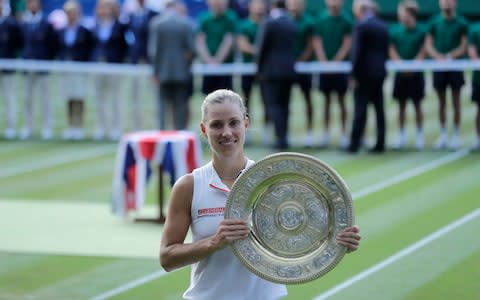How Wim Fissette, Johanna Konta's discard, became Wimbledon winner Angelique Kerber's ace in the pack

This was exactly what British tennis fans had been hoping for: an image of Belgian coach Wim Fissette holding his arms aloft as his client lifted the Venus Rosewater Dish.
Unfortunately, it came 12 months too late.
Last year, Fissette guided Johanna Konta to the Wimbledon semi-finals. Had Konta been able to take one of her early break points against Venus Williams – a player she started with a winning record against – their work together might have been rewarded in spectacular fashion.
But Williams regrouped like the five-time Wimbledon champion she is. And then, at the end of the season, Konta made the curious decision to cancel her collaboration with Fissette, even though it had carried her to a high point of No. 4 in the world.
As we saw on Saturday, Konta’s discard has since become Angelique Kerber’s ace in the pack. Fissette joined the new Wimbledon champion in the off-season. This was the coaching merry-go-around in action, and after January’s Australian Open, his present and former clients passed each other in opposite directions like figures on a town clock.

Week by week, the gap is only growing wider. Konta will stand at No. 50 in today’s new chart, her lowest position since Sept 2015. While Kerber – who began this year just outside the top 20 – will climb back up to No. 4 on the back of her magnificent upset win over Serena Williams. Life comes at you fast, as the young ’uns say.
During one of Kerber’s many interviews on Saturday night, she was asked for more details about the work she has done with Fissette.
“We sat down when we started working together and I said to him that I would really like to change my serve,” she replied. “I knew I had to improve it, especially in the big matches where I wasn’t serving really well and really fast. So we changed the technique a little bit and also making the second serve a little more confident. We are trying to improve my game, playing more aggressive.”
Fissette does not maintain as high a media profile as his opposite number on Saturday, Patrick Mouratoglou. (Although Mouratoglou, for once, was unusually absent from the debate around this tournament, having been asked not to speak to reporters by Williams – a move that must have felt deeply unnatural to such a garrulous man.)

But Fissette is known as one of the quiet achievers of the coaching pack. Having started out as Kim Clijsters’s hitting partner, he guided her comeback after the birth of her daughter Jada, which delivered three-hard court slams.
He then helped Germany’s big-serving Sabine Lisicki overachieve, with a run to the Wimbledon final in 2013, and also served stints with the current world No. 1 Simona Halep and the former world No. 1 Victoria Azarenka.
As for Kerber’s serve, the fruits were there on Saturday as she averaged 97mph on her first delivery, 5mph more than she managed while losing to Williams in the 2016 final here. Twenty-nine per cent of her serves didn’t come back, a significant improvement on 18 per cent two years ago.
“I was here last year with Jo in the semi-final,” said the ever-tactful Fissette on Saturday evening. “I'm lucky I can work with top players like Angelique and like Jo last year. With every player you have a different goal.
“I knew it was more difficult to win the French than Wimbledon. I knew I was going to have more of a chance winning Wimbledon with Angie. Of course it's huge satisfaction after all the work we put in. You start with a plan, you believe in that plan and you put the right people together. It's a huge team effort.”
Fissette was also asked about his players’ strong head-to-head record against Williams, which now stands at five wins from ten attempts. “It's something I am very proud of against the best player in the world,” he replied. “With five different players, they have beaten her.
“I try in different ways to show some videos focusing on the strengths of my players, so that they are convinced with their plan that they can do it. But I was also fortunate to work with some of the best players in the world. We know how tough it is to beat Serena.”

 Yahoo Sport
Yahoo Sport 





































